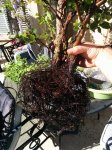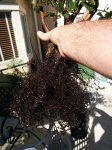symbiotic1
Mame
At the Bonsai-a-thon I picked up a nice cork oak from a vendor there called Legacy Cork Oaks. Here's a poor quality image of it for now, I'll post more detail shots tomorrow.

Besides starting this thread as a progression thread, I had a question that came up when I was repotting it today into more open soil and a wider pot. As I was bare rooting the tree I wondered how much of the root ball should I have taken off? This is only my first year of doing bare rooting of trees and also the first doing some on my own, so I'm guessing I was probably too conservative in my chopping. The tree is already leafing out and I didn't want to shock it too much.
I'm curious how much of this root ball you more experienced folk would have lobbed off.


I had only taken off about an inch or so of the rootball in these shots. Should I have gone further? To qualify that question: I'm currently just wanting the tree to keep growing vigorously and not trying to shrink the root ball for a bonsai pot for a few years at least. It may go into the ground next year if I have a more permanent place to plant it but for now it's in a pot.

Besides starting this thread as a progression thread, I had a question that came up when I was repotting it today into more open soil and a wider pot. As I was bare rooting the tree I wondered how much of the root ball should I have taken off? This is only my first year of doing bare rooting of trees and also the first doing some on my own, so I'm guessing I was probably too conservative in my chopping. The tree is already leafing out and I didn't want to shock it too much.
I'm curious how much of this root ball you more experienced folk would have lobbed off.


I had only taken off about an inch or so of the rootball in these shots. Should I have gone further? To qualify that question: I'm currently just wanting the tree to keep growing vigorously and not trying to shrink the root ball for a bonsai pot for a few years at least. It may go into the ground next year if I have a more permanent place to plant it but for now it's in a pot.




